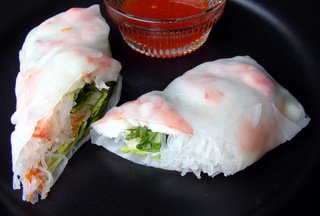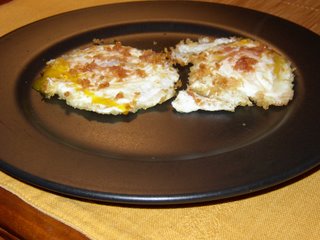One day I was riding down a local interstate highway with

So, what is a Grilled Sticky? If Cinnabon mated with French toast, their offspring would be Grilled Stickies. Imagine a large cinnamon sticky bun cut it into thick slices and fried in butter on a griddle until hot and crispy on the outside, and warm and soft on the inside.
Shortly after that conversation on the highway I noticed grilled stickies at the local grocery stores. I’m sure they had been there all along, but once my attention had been drawn to them, they were everywhere. Of course I had to try them! The grilled stickies available in the local grocery stores are actually manufactured and distributed by The College Diner at
I purchased a box of the stickies and followed the directions on the box for grilling them. In a non-stick skillet I heated a bit of oil and butter; oil for its high-heat cooking properties and butter for its flavoring and browning properties. The box contained one flattish loaf, about 7 inches long by 4 inches wide and 2 inches high, which I cut into slices about 1 ½ inches thick. I cooked the slices, cut side down, in the hot skillet. It is important to cook only the cut sides because the sugars on the sweet sticky sides would certainly burn. When the bottom was golden brown, I turned the slices to cook the other side.
Then I sat down with a hot cup of fresh coffee to enjoy a classic grilled sticky. The first bite told me why these treats are so popular. The grilled surface develops a thin crispy crust, which crackles when you bite into it and contrasts so nicely with the warm soft interior. The heating process also enhances the sweet flavors and fragrance of the cinnamon and brown sugar.
Grilled Stickies may be taken from the breakfast realm to the dessert domain via the Grilled Sticky Sundae. Just top a grilled sticky with ice cream, hot fudge sauce and whipped cream.
Leave it to those clever, frugal Pennsylvania Dutch cooks to discover a great way to resurrect stale sticky buns! You can try this with any sticky bun and I bet you will find they taste better grilled than they ever did fresh.
To discover other regional specialties from around the globe, visit “A Taste of Terroir” from Anna’s Cool Finds.
Tags: grilled stickies, Penn State, a taste of terroir, sticky bun

Thai Summer Rolls
I’ve recently become enamored with Thai food. Living here in the boonies there is limited opportunity to sample authentic Thai fare. When I travel on vacation I usually focus on the regional specialties of the area, but I’ve never been to Thailand. When business travel takes me to a city with Thai restaurants I’ve enjoyed Thai food immensely but it wasn’t until I cooked it myself that I really became a fan.
A friend of mine, a major chili head, loves Thai food. For his birthday I invited him and his wife over for a Thai dinner. Never having cooked Thai food before, I did a lot of research in preparation. I read cookbooks, articles, blogs, and reviewed many recipes. From this I developed what I thought was the perfect simple Thai dinner menu for a newbie Thai cook like me.
With dinner I served an Alsatian Riesling (Trimbach is my current favorite) which complemented the food perfectly and really stood up to the spicy flavors of the meal.
Dinner was an excellent success! Especially impressive were the summer rolls with shrimp. They were so much better than the ones I’ve had in restaurants. Perhaps that is because most restaurants prepare them so far in advance they get soggy or chewy, or maybe they skimp on the more expensive ingredients. My homemade version was wonderful, and so refreshing and satisfying on a hot summer day.
For those of you who may not know, a Thai summer roll is the Asian spring roll’s fresh cousin; not fried. Layers of fresh raw vegetables, fragrant herbs, and other ingredients are rolled in a softened rice paper wrapper and served with a flavorful dipping sauce.
My summer rolls looked and tasted spectacular! The colors of the coral shrimp and the dark green herbs peered through the translucent rice wrapper. The fresh flavors of mint, basil, and coriander tingled the taste buds while the dipping sauce added layers of sweet, tangy, and hot flavors to the mix.
My recipe here is a compilation of what I thought were the best components of the recipes I came across in my research. It may look long, but I like to give lots of details when sharing recipes. These details are especially important if you have never worked with rice paper wrappers before.
Thai Summer Rolls with Shrimp
(adapted from 4 different recipes)
8 servings
Although very labor intensive, your efforts will be appreciated. Be sure to have all components of the dish ready and laid out in order before you start the rolling process. Some components may be prepared in advance, as noted in the recipe. A salad spinner makes quick work of washing and drying all the fresh herbs.
12 large shrimp in shell (21 to 25 per lb)
½ onion
1 teaspoon whole black peppercorns
3 ounces rice vermicelli (fine cellophane noodles or bean threads)
3 tablespoons rice vinegar
2 tablespoons sugar
1/2 teaspoon salt
8 rice paper wrappers for spring rolls (8.5 inch diameter) plus a few spares
4 large Boston lettuce leaves, washed well and spun dry; Cut out and discard ribs, halving each leaf
40 fresh cilantro leaves washed well and spun dry
24 fresh mint leaves washed well and spun dry
24 fresh Thai basil leaves, washed well and spun dry
1/2 seedless cucumber, peeled, cored, and julienned
3 scallions, cut into 3-inch-long julienne strips
1/2 cup shredded carrot (1 large carrot)
Prepare Shrimp
Peel shrimp, reserving shells. Place shells in a 2 quart saucepan, half filled with water. Toss in a teaspoon of black peppercorns, some salt, and half a sliced onion. Bring to a simmer, cover and cook for 10 minutes, to make a flavorful broth.
Add shrimp and cook at a gentle simmer, uncovered, until just cooked through, about 3 minutes. Transfer shrimp with a slotted spoon to a bowl of ice water to stop cooking. Strain the cooking liquid to remove shells, onions, etc and return the cooking water to a boil to be used to cook the noodles.
Drain shrimp and pat dry. Cut each shrimp in half lengthwise, deveining if necessary. Shrimp may be prepared a day in advance and stored in the refrigerator.
Prepare the noodles
Stir together vinegar, sugar, and salt in a medium bowl until sugar is dissolved.
Add noodles to boiling shrimp liquid and cook until just tender, about 3 minutes.
Drain in a strainer, then rinse under cold running water and drain very well.With scissors, cut into the noodles several times. Stir noodles around and cut again. Repeat a few times. This will put the noodles into more manageable lengths.
Add the noodles to the vinegar mixture and toss to coat. If all the mixture is not absorbed by the time you use it, drain the noodles well in the strainer. Too much liquid in the noodles will make the rolls soggy.
May be prepared several hours in advance.
Rice Paper Rolls
Put a double thickness of paper towel on a work surface and fill a shallow baking pan, large enough to hold the rice paper wrappers, with warm water. Check rice paper rounds and use only those that have no holes.
Soak 1 round in warm water until just pliable, 30 seconds to 1 minute, and then carefully transfer to paper towels.Place another paper towel on top to blot excess water and remove.
Fill and roll the wrapper as described below, then repeat the process for each roll. You can use the same work surface paper towels for the entire process, but will probably change the blotting paper towel once.
Filling and Rolling
On the bottom 1/3 of the softened wrapper, place a lettuce leaf half. Top with some shredded carrot. Place a clump of noodles on top, distributing evenly, but leaving a 1 inch border on the sides. Top with some cucumber and scallions. Top that pile of ingredients with 3 cilantro leaves, 3 mint leaves and 2 basil leaves.
Just above this stack of ingredients, on the rice paper wrapper lay three split shrimp halves in a line, cut side up, all in the same orientation. This is important because the shrimp will be visible through the transparent wrapper when the rolls are served, and this will look very attractive. Just above the shrimp place two nicely shaped cilantro leaves on the rice paper wrapper, dark green side down.
Roll the wrapper from the bottom tightly over the ingredients. When it is halfway rolled, fold in the sides and continue rolling tightly.
If any tears develop while rolling just continue rolling it up. Then soak and blot another rice wrapper and place the torn roll on it and roll the second wrapper tightly around it.
Place completed rolls in a flat baking pan lined with a dampened paper towel (wet the towel and wring it out). Top with another dampened paper towel. It is very important to keep them moist.
Repeat the above to make all 8 rolls. Cover pan of summer rolls with plastic wrap and refrigerate at least ½ hour. They are best served the same day.
Serving
Shortly before serving, remove pan of rolls from the refrigerator, but keep them covered, until they are approaching room temperature. Slice each roll diagonally in half. Arrange on serving dish with your choice of dipping sauces.
Hot and Sweet Dipping Sauce
From Gourmet Magazine April 1996
Just these few simple ingredients create a complex combination of flavors. Note that this is not the sauce that is shown in the picture here. One of several sauces I served, this one seemed most complementary with the Summer Rolls.
1/2 cup distilled white vinegar
1/2 cup sugar
1 to 2 garlic cloves, minced
1/4 teaspoon salt
1 1/2 teaspoons dried hot red pepper flakes (preferably Thai)
In a small saucepan bring vinegar to a boil. Stir in sugar and simmer 5 minutes. With a mortar and pestle or in a bowl with back of a spoon pound or mash garlic to a paste with salt. Add red pepper flakes and combine well. Stir garlic paste into vinegar and cool.
Sauce keeps, sealed in a jar and chilled, 5 days.
Serve sauce at room temperature in individual condiment bowls for dipping.
Yield: about 1/2 cup.
Tags: Thai summer rolls, Recipe, shrimp, dipping sauce

Ice Cream Adventures - Fresh Raspberry Ice Cream
For years I had been eyeing a fancy ice cream maker but was hesitant to buy it because it was somewhat expensive for a single-purpose appliance that is not used regularly. But a while back when I saw that Amazon had it on sale, with free shipping, and a $20 rebate, I went for it.
It requires neither ice, nor salt, nor the pre-freezing of a canister. You just pour in the ice cream mixture, push a button and in 30 minutes you have wonderful homemade ice cream. It works with its own built-in chiller unit, which is why it weighs 37 pounds. Good thing I got free shipping!
The first ice cream I tried was raspberry ice cream made with fresh raspberries from a friend's garden. It was wonderful; smooth and creamy with an intense, fresh raspberry flavor. Like many of my kitchen experiments, I combined parts of several other recipes to come up with this one.

Since then, I’ve used my ice cream maker for many other flavors of ice cream, with great success. But every summer during raspberry season, I have to make this one.
Note that the small amount of vodka acts as antifreeze, discouraging any leftover ice cream from freezing too hard in the freezer.
Fresh Raspberry Ice Cream
Yield: 1 quart
2 cups fresh raspberries
1 1/3 cups sugar, divided
1 3/4 cups heavy cream
2 eggs, beaten
1/2 tablespoon lemon juice
1 tablespoon vodka
Toss raspberries with 1/3 cup sugar and allow t sit at room temperature for 1/2 hour or longer, stirring occasionally, while you prepare the rest of the recipe. The berries will exude their juices and breakdown.
In a medium saucepan bring cream to a simmer. Meanwhile, whisk eggs with 1 cup sugar until sugar is almost dissolved. Slowly pour hot cream into eggs, a little at a time so as not to scramble the eggs. Whisk until smooth. Pour egg mixture back into saucepan and simmer over medium-low heat, stirring constantly, until mixture reaches 170 degrees, about 6 minutes. Strain and chill.
To expedite the chilling process, you can pour the custard mixture into a metal bowl and set it inside a larger bowl of ice and water. Stir frequently until custard is cool and then chill in the refrigerator.
Puree the sweetened berries in a blender with lemon juice and vodka. Strain through a fine strainer to remove seeds. You should have about 1 cup of strained puree. Chill puree.
Mix together the chilled custard and chilled puree. Freeze in ice cream maker according to the manufacturer's instructions.
Yield - 1 quart.
Tags: raspberry ice cream, Recipe, homemade, ice cream maker

Savannah Low Country Boil
Last Spring I spent a few days in Savannah, Georgia as a first time visitor. Savannah is a lovely and interesting little town, although quite touristy, especially along the popular Riverfront. But it has a lot to offer a hungry food enthusiast from the sticks.
Some of my more memorable Savannah taste experiences were - the still-warm pralines from River Street Sweets, sipping the mango bubble tea on the second story outdoor porch of the Boba Cafe while watching the street activity at the City Market down below, and Cobblestone Café’s incredible breakfast of shrimp and cheese grits with gravy. I still dream about that last one!
Surprisingly, the most disappointing dish I tried was one of the major specialties of the region. When I first read about Low Country Boil (a.k.a. Beaufort or Frogmore Stew) it sounded delicious. I could almost taste it in my mind’s mouth - succulent shrimp simmered with flavorful smoked sausage in a spicy broth with new potatoes, sweet onions, and fresh corn on the cob. I couldn’t wait to try it in its native habitat.
My big mistake was trying Low Country Boil at one of the well-touristed River Street restaurants. The shrimp were overcooked, the potatoes undercooked, the corn was mushy, and the broth was blander than dishwater. But I knew this dish had potential if properly prepared. My mind’s mouth couldn’t be wrong!
When I got home I set forth to create the Low Country Boil of my dreams. I knew I shouldn’t just throw everything together in a pot and boil it. Each ingredient cooks differently, so I determined the proper sequence and timing for adding each ingredient to the pot so each would be cooked perfectly. To make the broth flavorful and spicy I allowed the seasonings to spend time just sitting in the water to fully release their flavors. Simmering the smoked sausage in this flavored water for a little while before adding any other ingredients added a smoky flavor to the broth. Fresh lemon supplied a spark of acid.
Now this was Low Country Boil! The shrimp were juicy and tender. The smoked sausage and seasoned broth exchanged flavors with each other, to the benefit of both of them. The potatoes were cooked just perfectly and had absorbed enough of the seasoned broth to be flavorful with a zip of spiciness. The corn was moist and tender and snapped when bitten.
Do try this at home! It is the perfect casual summertime meal and may easily be doubled or tripled to feed a crowd (but be sure to use a very big pot).
Lydia’s Low Country Boil
Serves 4 - 6
2 quarts water
4 tablespoons Old Bay seasoning
1 pound smoked sausage, cut into 2-3 inch lengths
½ fresh lemon
1 large sweet onion, peeled and cut into quarters
3 – 4 ears of fresh corn, each cut into 3 pieces
4 large red skinned potatoes, scrubbed and cut into quarters
1 1/2 pounds shrimp
In a large pot mix water and Old Bay seasoning. Stir well to dissolve seasonings and allow to sit at room temperature for 1 – 2 hours. If you are in a rush, simmer it gently for 15 minutes.
Bring seasoned water to a simmer and add smoked sausage. Simmer for 10 minutes.
Add onions and potato and simmer for 10 minutes.
Squeeze the juice from the lemon into the pot and toss the lemon shell in as well. Add the corn and simmer for 5 – 10 minutes, until the corn is just tender.
Add the shrimp and simmer for 5 minutes. Remove the pot from the heat, cover and let rest for 5 minutes.
Serve in large soup plates with plenty of napkins and thick slices of toasted bread on the side for dunking into the delicious broth.
Tags: low country boil, Savannah, recipe, frogmore stew

Glorified Simplicity – Fried Eggs with Crunchy Bread Crumbs
I admire recipes that take a basic concept and elevate it to a new height with a few simple flourishes. This is one of those.
The textures in this dish are wonderful! Jumbo Japanese bread crumbs, pan-toasted till just golden, envelop basic fried eggs, precluding the need for toast. The crispy crumbs and the crunchy crystals of coarse salt contrast marvelously with the creamy egg yolks and tender egg whites. The flavors of the olive oil and the (optional) last-minute tincture of red wine vinegar are unusual but delicious touches. This recipe is an interesting twist on the typical fried eggs breakfast but it also makes a nice lunch or a simple supper on top of simply dressed greens.
The original recipe for this dish came from The Zuni Cafe Cookbook by Judy Rodgers, by way of The Best American Recipes 2003 – 2004. Chef Rodgers uses homemade bread crumbs made from ciabatta or other chewy peasant bread. Instead, I use panko, the coarse Japanese breadcrumbs available in Asian grocery stores and the ethnic section of most regular grocery stores. Panko is a cupboard staple for me, which streamlines the preparation of this dish to mere minutes and makes it even crunchier.
Fried Eggs with Crunchy Bread Crumbs
Adapted from The Zuni Cafe Cookbook by Judy Rodgers
Serves 1
3 tablespoons panko bread crumbs
coarse salt, such as fleur de sel or kosher salt
2 tablespoons extra-virgin olive oil, divided
2 large eggs
1 teaspoon red wine vinegar (optional)

Sprinkle the bread crumbs with salt to taste in a small bowl. Add 1 tablespoon of olive oil and stir to coat evenly.
Place the crumbs in a 6- or 8-inch omelet pan or nonstick skillet over medium heat. Let the crumbs warm through, and then swirl the pan as they begin drying out – they will make a quiet, staticky sound. Stir once or twice.
When the crumbs begin to turn color, quickly add the remaining 1 tablespoon of oil. Stir and flatten the crumbs evenly in the center of the pan. Crack the eggs directlyonto the crumbs and cook to your preference.
I like to make these over easy so that both sides of the eggs wear a crunchy crumb cloak. After the bottoms of the eggs have begun to set, I flip them and cook for just seconds on the other side. Any loose crumbs in the pan will adhere to the just-flipped side of the eggs.
With a wide spatula, lift each egg from the pan and gently flip it back, onto a warm plate. Scrape any crumbs remaining in the skillet over the eggs. Immediately add the vinegar to the hot pan, swirling it once. Pour the sizzling vinegar over the eggs and serve immediately.
I sometimes make the vinegar optional, especially if I’m serving this to someone else for breakfast. The fumes of hot vinegar are not appetizing to everyone in the morning.
Tags: fried eggs, bread crumbs, recipe, Zuni Cafe